A plethora of doggos spend a lifetime wandering the streets, cut off from what can be called the minimum humane conditions. Even though there are around 3,500 dog shelters currently established in the U.S., according to 2022 statistics – there are still many dogs to be helped.
Sophie shared the destiny of her fellow wanderers for the good part of her life until a little girl sprung into action and provided her with a shelter.
Unfortunately, that didn’t last long, as the girl’s mother didn’t want Sophie around, and this poor Pittie girl was returned back to the street.
But then, just when it seemed that Sophie’s fate would be a lost cause, a volunteer from Redland, California, showed up!
Shuffling From One Place To Another Until A Rescuer Finally Showed Up
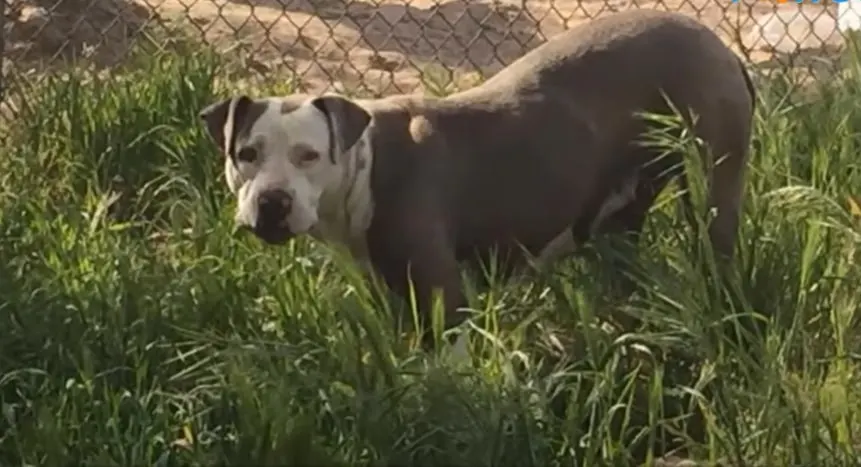
Faith Easdale, the volunteer at Dream Fetchers: Project Rescue, from Huntington Beach, California, received word about this poor Pittie girl wandering the streets. And, for things to be worse – this poor doggo was pregnant.
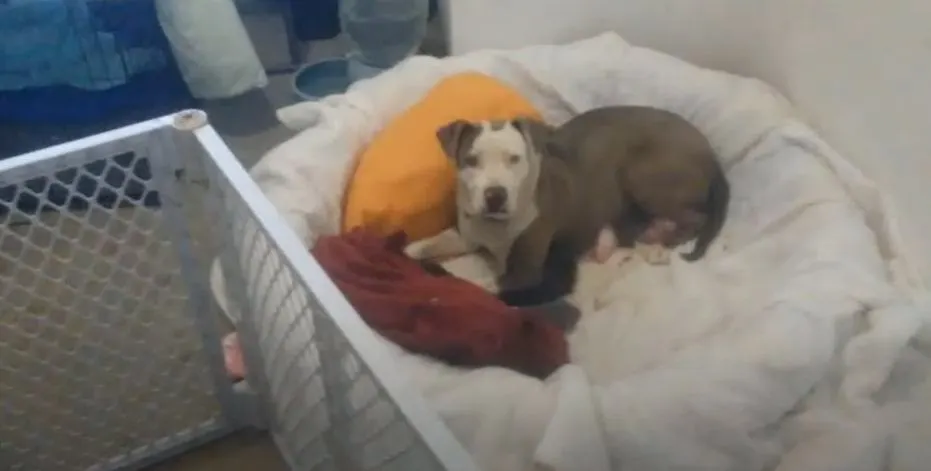
Due to constant shuffling from one place to another, Sophie was skittish and wary of people. Still, Easdale was inclined to help her no matter what! Together with her fellow volunteers, Easdale slowly approached Sophie, lured her into a car, and drove her to her home.
The Preciado Family Was The First Step Towards A Furever Home
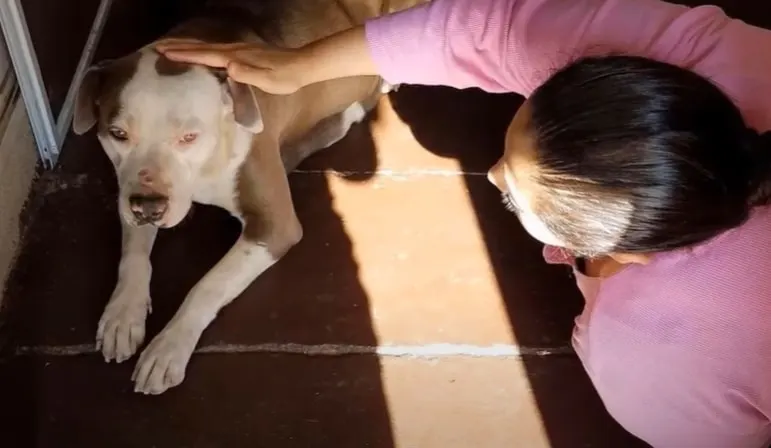
Little by little, this Pittie mama-to-be was regaining her trust in people, but she still had a long way to go. Easdale set her up with a beautiful foster family. Klaudya Preciado and her family were more than happy to welcome Sophie to their home.
After all this time, Sophie was finally in a safe place where she could deliver her litter without worrying about her puppies not being safe.
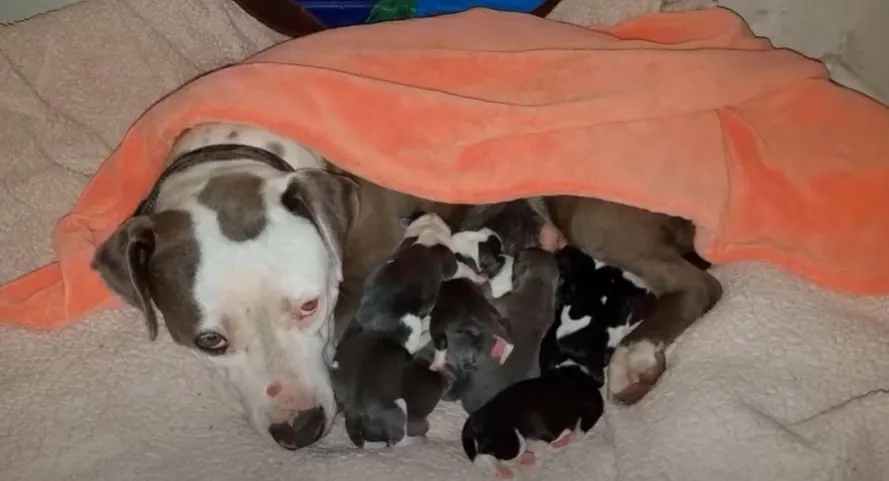
A few days later, adorable Pittie babies were born in Sophie’s foster home. It was a moment of pure joy and happiness for everyone, especially this Pittie mama who seemed relieved to finally have her babies next to her.
Allen Boartfield – Sophie’s Whisperer

Even after weeks in a foster home, Sophie was still suspicious about anyone getting close to her babies – except for Allen Boartfield, another volunteer working for the DFPR.
He was basically her own, private whisperer, around whom Sophie seemed so calm and relaxed. After a few days of working closely with Sophie, she let him pet her puppies and even hold them in his arms.
It seemed that Sophie really loved Allen’s gentle approach and the way he addressed her every single time he was around her. Once a skittish Pittie girl, she was all lovey-dovey next to Allen!
A Happily Ever After For Sophie And Her Babies
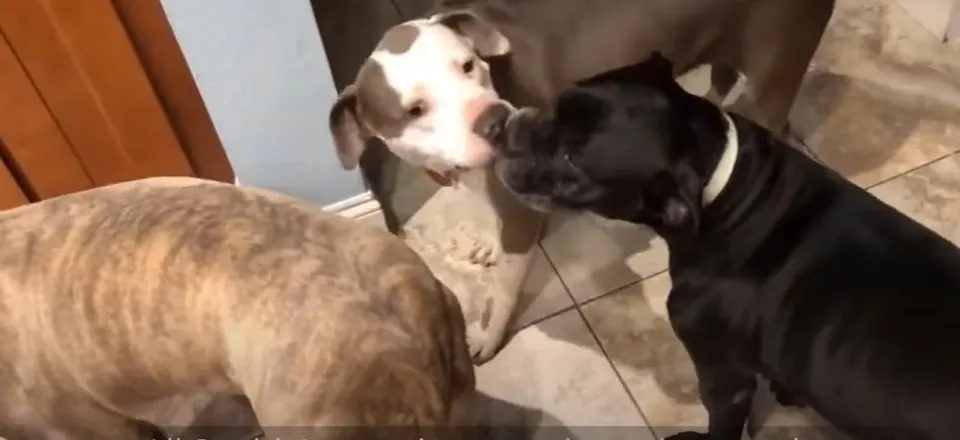
Sophie’s puppies were getting bigger and stronger every day until they were finally big enough to go to a furever home. Every single one of them was successfully nurtured and socialized, all thanks to a wonderful team of volunteers!
And, Sophie – she couldn’t be happier! After six months of intensive socialization with her caregivers, she was far from being her old self. Sophie was now a brand new girl who was constantly giving smiles to everyone!

If there’s one thing we can say with certainty, it’s that Sophie and her puppies really deserve what they finally got – a warm, cozy home and a loving family!
Ever wondered why your furry friend can’t seem to resist giving you those slobbery kisses? Dogs have a unique way of showing affection, and one common behavior they exhibit is licking their human companions. It’s a behavior that has puzzled many pet owners, but there’s more to it than meets the eye.
Understanding Canine Behavior
The Basics of Dog Communication
Dogs use licking as a form of communication. It’s their way of expressing different feelings and needs. For example, licking your face can be a sign of affection or a request for attention. Understanding this basic form of dog communication can deepen your bond with your furry friend.
The Instinctual Aspect
Licking is also an instinctual behavior in dogs. In the wild, mother dogs lick their puppies to clean them and stimulate their circulation. This instinct stays with them, and they transfer this behavior to humans as a way of showing care and establishing a connection. So, when your dog licks you, it’s their way of nurturing and bonding with you.
Why Do Dogs Lick Humans?
A Sign of Affection
Dogs lick humans as a way to show affection. It’s their natural instinct to express love and closeness to their human family members. When a dog licks you, it’s like giving you a gentle kiss to display their fondness for you.
Seeking Attention or Food
Licking can also be a way for dogs to seek attention or food from their owners. If your dog licks you when you’re eating or not paying attention to them, it could be their way of asking for something. It’s their way of communicating their needs to you.
Investigating Scents
Dogs use licking as a way to investigate scents. By licking you, they can gather information about where you’ve been, who you’ve met, and what you’ve been doing. It’s a way for them to learn more about their environment and the people in it.
Learned Behavior from Puppyhood
Licking is a learned behavior that dogs pick up from puppyhood. When they are young, puppies lick their mother as a way to bond with her and seek affection. As they grow up, they carry this behavior into their relationship with humans, using licking as a way to bond and show love.
These are some of the reasons why dogs lick humans, showing their affection, seeking attention, investigating scents, and carrying on learned behaviors from their puppy days.
The Science Behind Dog Licks
Taste and Texture Curiosity
Dogs lick humans primarily out of taste and texture curiosity. Your skin, with its unique scent and salty taste, intrigues them. This behavior harks back to their ancestral instincts of exploring and understanding their environment through sensory cues. When they lick you, they are essentially “tasting” you to learn more about you. Moreover, the different textures of human skin, hair, and clothing provide dogs with varied tactile sensations that stimulate their senses and spark their curiosity.
Endorphins and Pleasure
When dogs lick you, it triggers the release of endorphins in their brains, creating a sense of pleasure and comfort. This sensation reinforces the behavior positively, making them more likely to lick you in the future. Endorphins are natural feel-good chemicals that promote relaxation and reduce stress, both for dogs and humans. So, the next time your furry companion licks you, remember that it’s not just about affection; it’s also about experiencing a satisfying and pleasurable feeling.
Deciphering Lick Patterns
Frequency and Context of Licking
When it comes to why dogs lick humans, the frequency and context of their licking behavior can give valuable insights into their intentions. The number of licks and when they occur can vary based on different factors. For example, if your dog licks you when you return home, it might be their way of showing excitement and greeting you. On the other hand, if they lick you during playtime, it could be a sign of affection and happiness. Observing the timing and situations in which your dog licks you can help you understand their emotions and communication better.
Licks Associated with Dominance
Dogs licking humans can sometimes be linked to establishing dominance. In a pack setting, licking can be a way for dogs to assert their position. If your dog tends to lick you excessively or in a more assertive manner, it could be their way of trying to show dominance. It’s essential to pay attention to other body language cues accompanying the licking behavior to determine if it stems from a place of dominance. Understanding the role of dominance in your dog’s licking habits can help you establish boundaries and reinforce positive behaviors.
Health and Hygiene Considerations
When Licking Becomes Excessive
If your furry friend’s licking is getting out of hand, it could indicate an underlying issue. Excessive licking might suggest discomfort, anxiety, or even pain. It’s essential to observe any changes in your dog’s behavior to address potential concerns promptly. Consulting with a veterinarian can help pinpoint the cause of this behavior and ensure your dog’s well-being.
Potential Health Risks for Humans
While it’s common for dogs to show affection through licking, there are some health risks for humans to be aware of. Dog saliva may contain bacteria that could lead to infections if you have any open wounds or a weakened immune system. Additionally, certain allergies can be triggered by contact with dog saliva, causing skin irritation or other reactions. Practicing good hygiene, such as washing your hands after contact with your dog, can help minimize these risks and keep both you and your canine companion healthy.
Managing and Responding to Licking Behavior
Training Alternatives to Licking
To redirect your dog’s licking behavior, provide suitable chew toys or bones to keep them engaged. Offering a Frozen Kong toy filled with treats can keep them occupied and prevent them from licking excessively. You can also utilize puzzle toys that challenge their minds and keep them focused on a different activity. By using these alternatives, you can distract your dog effectively and discourage excessive licking behaviors.
Positive Reinforcement Strategies
Encouraging positive behavior through rewards is key in modifying your dog’s actions. When your dog refrains from licking and follows a command, reward them with treats or verbal praise. This positive reinforcement helps them associate good behavior with rewards and encourages them to continue the desired actions. Consistency in rewarding positive behavior is crucial in reinforcing the message that not licking leads to positive outcomes.
Conclusion
So, there you have it – dogs lick humans for various reasons, from communication to showing affection and investigating scents. It’s a natural behavior that brings pleasure and reduces stress for both parties. When it comes to managing licking behavior, redirecting with toys and using positive reinforcement techniques can be effective. By understanding your dog’s emotions and setting boundaries, you can encourage positive behaviors. Remember, consistency is key in reinforcing good behavior and maintaining a healthy relationship with your furry friend. Always consider your dog’s well-being and hygiene when addressing excessive licking. Keep these tips in mind to foster a strong bond with your canine companion.
Frequently Asked Questions
Why do dogs lick their owners?
Dogs lick their owners as a form of communication, affection, scent investigation, and learned behavior. It is a natural instinct for dogs to show love and curiosity about taste and texture.
How does licking benefit dogs and humans?
Licking releases endorphins, creating pleasure and reducing stress for both dogs and humans. It strengthens the bond between the dog and its owner and can be a soothing gesture during moments of anxiety or excitement.
How can owners manage excessive licking behavior?
Owners can redirect licking behavior by providing chew toys or engaging puzzle toys. Using positive reinforcement strategies, like rewarding good behavior with treats or verbal praise, can help modify a dog’s actions effectively.
Why is consistency important in responding to licking behavior?
Consistency in rewarding positive behavior reinforces the message that not licking leads to positive outcomes. It helps set boundaries and reinforces desired behaviors over time.
[no_toc]

Hey there, I’m Janet Brooks, a dog-loving student from California. I’m all about helping pups in need, especially those without homes. Me and my awesome friends work together to give shelter and love to stray dogs. Oh, and I also write blogs about dogs to share helpful info.